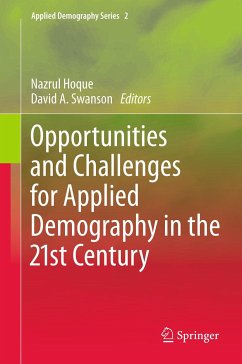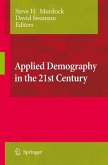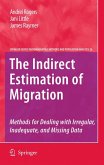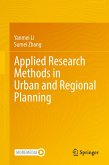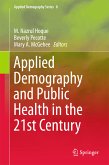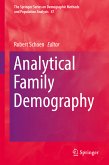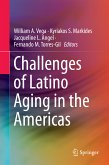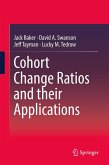Opportunities and Challenges for Applied Demography in the 21st Century (eBook, PDF)
Redaktion: Hoque, Nazrul; Swanson, David A.


Alle Infos zum eBook verschenken

Opportunities and Challenges for Applied Demography in the 21st Century (eBook, PDF)
Redaktion: Hoque, Nazrul; Swanson, David A.
- Format: PDF
- Merkliste
- Auf die Merkliste
- Bewerten Bewerten
- Teilen
- Produkt teilen
- Produkterinnerung
- Produkterinnerung

Hier können Sie sich einloggen

Bitte loggen Sie sich zunächst in Ihr Kundenkonto ein oder registrieren Sie sich bei bücher.de, um das eBook-Abo tolino select nutzen zu können.
Applied demography continues its rapid pace of evolution in concert with the emerging trends of the 21 st century. One significant area of change is the extension of applied demography beyond the United States; this book includes material dealing with applied demography in Australia, Canada, Estonia, and Mexico.
Opportunities and Challenges for Applied Demography in the 21 st Century presents a score of selected papers from the second post-2000 national conference on Applied Demography, held in San Antonio, Texas, in January, 2010, under the sponsorship of the Institute for Demographic and…mehr
- Geräte: PC
- ohne Kopierschutz
- eBook Hilfe
- Größe: 7.33MB
![Applied Demography in the 21st Century (eBook, PDF) Applied Demography in the 21st Century (eBook, PDF)]() Applied Demography in the 21st Century (eBook, PDF)113,95 €
Applied Demography in the 21st Century (eBook, PDF)113,95 €![The Indirect Estimation of Migration (eBook, PDF) The Indirect Estimation of Migration (eBook, PDF)]() Andrei RogersThe Indirect Estimation of Migration (eBook, PDF)81,95 €
Andrei RogersThe Indirect Estimation of Migration (eBook, PDF)81,95 €![Applied Research Methods in Urban and Regional Planning (eBook, PDF) Applied Research Methods in Urban and Regional Planning (eBook, PDF)]() Yanmei LiApplied Research Methods in Urban and Regional Planning (eBook, PDF)53,95 €
Yanmei LiApplied Research Methods in Urban and Regional Planning (eBook, PDF)53,95 €![Applied Demography and Public Health in the 21st Century (eBook, PDF) Applied Demography and Public Health in the 21st Century (eBook, PDF)]() Applied Demography and Public Health in the 21st Century (eBook, PDF)129,95 €
Applied Demography and Public Health in the 21st Century (eBook, PDF)129,95 €![Analytical Family Demography (eBook, PDF) Analytical Family Demography (eBook, PDF)]() Analytical Family Demography (eBook, PDF)113,95 €
Analytical Family Demography (eBook, PDF)113,95 €![Challenges of Latino Aging in the Americas (eBook, PDF) Challenges of Latino Aging in the Americas (eBook, PDF)]() Challenges of Latino Aging in the Americas (eBook, PDF)73,95 €
Challenges of Latino Aging in the Americas (eBook, PDF)73,95 €![Cohort Change Ratios and their Applications (eBook, PDF) Cohort Change Ratios and their Applications (eBook, PDF)]() Jack BakerCohort Change Ratios and their Applications (eBook, PDF)40,95 €
Jack BakerCohort Change Ratios and their Applications (eBook, PDF)40,95 €-
-
-
Opportunities and Challenges for Applied Demography in the 21st Century presents a score of selected papers from the second post-2000 national conference on Applied Demography, held in San Antonio, Texas, in January, 2010, under the sponsorship of the Institute for Demographic and Socioeconomic Research at The University of Texas at San Antonio.
Coverage includes the assembly of data by government agencies, with a focus on issues facing the United States; demographic issues associated with globalization; business demography and health demography, as well as a section examining methodological advances in the areas of estimation and projection.
Dieser Download kann aus rechtlichen Gründen nur mit Rechnungsadresse in A, B, BG, CY, CZ, D, DK, EW, E, FIN, F, GR, HR, H, IRL, I, LT, L, LR, M, NL, PL, P, R, S, SLO, SK ausgeliefert werden.
- Produktdetails
- Verlag: Springer Netherlands
- Seitenzahl: 406
- Erscheinungstermin: 13. Januar 2013
- Englisch
- ISBN-13: 9789400722972
- Artikelnr.: 37773798
- Verlag: Springer Netherlands
- Seitenzahl: 406
- Erscheinungstermin: 13. Januar 2013
- Englisch
- ISBN-13: 9789400722972
- Artikelnr.: 37773798
- Herstellerkennzeichnung Die Herstellerinformationen sind derzeit nicht verfügbar.
